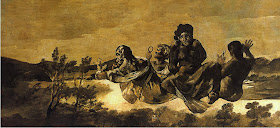The Dog by Goya
The painting I’ve chosen has been The Dog by Francisco de Goya. It was painted in 1819 and was exhibit ed in the Prado Museum in 1881, it was donated by him. It’s an oil painting on plaster and its dimensions are 131,5 cm × 79,3 cm. Its belong from the Black Paintings. The painting was in La Quinta del Sordo, Goya’s house, but at the moment the painting is in the Prado Museum.
DESCRIPTION
The painting is divided into two parts: the
upper part, is a dirty ochre and a smaller section that is curved in dark brown
which fades to black and it slopes to the right. Over the top of this lower
section the dog's head can be seen, its nose up, its ears back and its eyes
looking up and to the right. This painting might represent the fear, the
loneliness and even only a bird playing with two small birds. The Australian
critic, Robert Hughes said that:
"We do not know what it means, but its pathos moves us on a level below narrative."
This
scene, is in vertical format, is completely blank in over two-thirds parts of
the painting. The separation between the sky and earth is completely arbitrary,
because both have a yellowish tone so is difficult to differentiate them.
CONNECTION WITH
THE STYLE
Francisco de Goya was the introducer of the
Romanticism style in art. In works of Goya we can found romanticism in
paintings such as The 3rd of
May 1808 in Madrid (1814), the collection of etchings of the disasters of War (1810-1815) or the Black
Paintings, including The Dog. The
freedom of the compositions, the passional nature of the motives and the domain
of the imagination, makes Goya a founder of the later romantic master as Eugène
Delacroix (1798-1863) who took inspiration.
ANALYSIS OF THE
PAINTING
This painting is called in this way, because the
whole fourteen scenes which this work has been popularized under the title Black Paintings. This set of fourteen
scenes is called in this way for the use in them dark and black pigments and it has
also so somber topics. They decorated two rooms, on the ground and high floor, of
the famous house referred the Quinta Del Sordo, then the
paintings were moved to a plaster.
Las Parcas (down) and La Romeria de San Isidro (up), by Goya, are some examples of Black
Paintings
In The Dog is emphasize the features that characterize it as "black painting", which are the dark tones, dark motifs; it shows nocturnal themes characters which shows disturbing. With this painting, Goya arrived at the culmination stage of his work, because it was made in the latter part of his life, and also because he works as with total freedom exploring themes and techniques that bring it closer to modernity.
This work represents, at the same time
everything and nothing. The nothingness, because it represents only the image
of a dog in absolute loneliness and all because in that image, apparently so
simple, it represents the world in itself, also the presence of a living being,
in this case, a dog but could also be a man in the universe and all the
possibilities it has to be in that universe, such as experiencing human
feelings such as fear, emptiness, or freedom.
WHY I LIKE THIS
PAINTING
In my opinion, I like this painting because is a painting very
mysterious, but in deep, it has a lot of history. I like also because each person can see a
different thing and the contrast of dark colors with lights colors are very
good.
SOURCES:
http://www.artehistoria.jcyl.es/v2/obras/660.htm



 Source:
Source:
Hello Laura,
ReplyDeleteYou haven't corrected the mistakes I corrected you previously. Do it, please. Check my last message and correct all I told you.
You haven't corrected the mistakes. So your final mark is 6. See you!
ReplyDelete